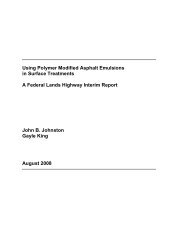journal - TSP2
journal - TSP2
journal - TSP2
Create successful ePaper yourself
Turn your PDF publications into a flip-book with our unique Google optimized e-Paper software.
Composite Layering Systems<br />
for Asphalt Rubber Overlays<br />
By Shakir Shatnawi, Ph.D., P.E.<br />
Asphalt rubber composite<br />
layer systems for<br />
pavement preservation<br />
and rehabilitation utilize<br />
asphalt rubber membrane interlayers.<br />
These interlayers are usually made<br />
of thin asphalt rubber membranes<br />
which possess low stiffness and high<br />
deformability.<br />
The primary role of these interlayers<br />
is to help dissipate the stress and strain<br />
energies that accumulate at the crack tips<br />
of an existing flexible or rigid pavement,<br />
which would otherwise get transferred<br />
to the underside of the HMA overlay.<br />
The dissipation of these high level<br />
stresses and strains minimizes the<br />
potential of reflective fatigue cracking<br />
in the HMA overlays. Another benefit<br />
of an interlayer is its ability to prevent<br />
water intrusion into the lower layers<br />
of the pavement structure, thus<br />
protecting the structural integrity of<br />
the pavement system.<br />
Asphalt rubber chip seals have<br />
been used effectively as interlayers<br />
over distressed flexible and rigid<br />
pavements, and as a surface treatment.<br />
In California, these interlayers are<br />
known as rubberized stress absorbing<br />
membrane interlayers (SAMI-R) or<br />
asphalt rubber aggregate membrane<br />
interlayers (ARAMI), and the terms<br />
are often used interchangeably in the<br />
pavement technical literature.<br />
A schematic of a pavement section<br />
showing a typical ARAMI is shown<br />
in Fig. 1. When used as a surface, it<br />
is called asphalt rubber aggregate<br />
membrane (ARAM) or simply a<br />
rubberized chip seal.<br />
INTERLAYERS EXTEND<br />
PAVEMENT LIFE<br />
Interlayers can extend the life<br />
of preservation and rehabilitation<br />
strategies. The magnitude of life<br />
extension depends on many factors,<br />
Fig. 1. Schematic of a cracked pavement receiving an ARAMI prior to an HMA overlay<br />
including existing pavement<br />
condition, traffic loading, climatic and<br />
environmental conditions, and the<br />
type and engineering properties of the<br />
interlayer used.<br />
The excellent performance of these<br />
interlayers is primarily due to the<br />
unique elastic properties, and superior<br />
aging characteristics of the asphalt<br />
rubber binder, which can withstand<br />
as much as five times more strain than<br />
the unmodified asphalt binder. Fig. 2<br />
demonstrates the aging superiority<br />
of an ARAM as demonstrated in the<br />
elasticity of the asphalt rubber binder<br />
after 10 years in service.<br />
ARAMI (or SAMI-R) have been<br />
widely used placed prior to placement<br />
of an overlay, a slurry seal, or micro<br />
surfacing. These interlayers consists<br />
of spraying 0.55 to 0.65 gal. per sq.<br />
yd.) of hot asphalt rubber binder over<br />
a pavement surface, followed by the<br />
application of 35 to 45 lb. per sq. yd. of<br />
clean 9.5 mm (3/8 in.) aggregate size<br />
chips over the asphalt rubber, followed<br />
by rolling with pneumatic tire rollers.<br />
Sweeping follows to remove loose<br />
chips before the placement of the<br />
surface course.<br />
In California, SAMI-R’s have been<br />
used in a number of applications,<br />
collectively referred to as Composite<br />
Layering Systems I, II, III, and IV.<br />
• System I consists of an ARAM<br />
cape seal. The ARAM (9.5 mm) is<br />
applied directly on existing HMA<br />
surface, followed by a Type II slurry<br />
seal.<br />
• System II consists of an ARAM<br />
cape seal with a leveling course.<br />
In this system an HMA leveling<br />
course (19 mm minimum) is<br />
placed on top of existing pavement<br />
followed by an ARAM (9.5mm),<br />
then Type II slurry seal.<br />
Summer 2012 pavement preservation <strong>journal</strong> 23
















